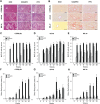Longitudinal characterization of diet-induced genetic murine models of non-alcoholic steatohepatitis with metabolic, histological, and transcriptomic hallmarks of human patients
- PMID: 31023717
- PMCID: PMC6550083
- DOI: 10.1242/bio.041251
Longitudinal characterization of diet-induced genetic murine models of non-alcoholic steatohepatitis with metabolic, histological, and transcriptomic hallmarks of human patients
Abstract
Non-alcoholic steatohepatitis (NASH) is a fast-growing liver disease in the Western world. Currently, only a few animal models show both the metabolic and histological features of human NASH. We aimed to explore murine NASH models in a time dependent manner that exhibit metabolic, histological and transcriptomic hallmarks of human NASH. For this, the murine strains C57BL/6J, ob/ob, and KK-Ay were used and three types of nutritional regimes were administered: normal chow diet (NCD); high-fat, high-fructose, and high-cholesterol diet (fast food diet; FFD); or choline-deficient, L-amino acid-defined, high-fat diet (CDAHFD), for 2, 4, 8, 12, 18, 24, and 30 weeks. All strains under the FFD and CDAHFD regimes developed steatohepatitis. Among the strains treated with FFD, the non-alcoholic fatty liver disease (NAFLD) activity score, fibrosis progression and metabolic abnormalities such as hyperinsulinemia and obesity were more pronounced in ob/ob mice than in C57BL/6J and KK-Ay mice. In ob/ob mice fed FFD, the development of hepatic crown-like structures was confirmed. Furthermore, molecular pathways involved in steatohepatitis and fibrosis showed significant changes from as early as 2 weeks of starting the FFD regime. Ob/ob mice fed FFD showed metabolic, histological, and transcriptomic dysfunctions similar to human NASH, suggesting their potential as an experimental model to discover novel drugs for NASH.
Keywords: Fast food; Fibrosis; Hyperinsulinemia; Non-alcoholic steatohepatitis; Obesity.
© 2019. Published by The Company of Biologists Ltd.
Conflict of interest statement
Competing interestsThe authors declare no competing or financial interests.
Figures






References
-
- Abdelmalek M. F., Suzuki A., Guy C., Unalp-Arida A., Colvin R., Johnson R. J., Diehl A. M. and Nonalcoholic Steatohepatitis Clinical Research Network. (2010). Increased fructose consumption is associated with fibrosis severity in patients with nonalcoholic fatty liver disease. Hepatology 51, 1961-1971. 10.1002/hep.23535 - DOI - PMC - PubMed
-
- Brunt E. M., Kleiner D. E., Wilson L. A., Belt P., Neuschwander-Tetri B. A. and Nonalcoholic Steatohepatitis Clinical Research Network. (2011). Nonalcoholic fatty liver disease (NAFLD) activity score and the histopathologic diagnosis in NAFLD: distinct clinicopathologic meanings. Hepatology 53, 810-820. 10.1002/hep.24127 - DOI - PMC - PubMed
LinkOut - more resources
Full Text Sources
Molecular Biology Databases
Miscellaneous

